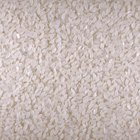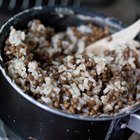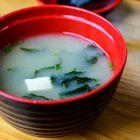ehaurylik/iStock/GettyImages
Our understanding of nutrition is constantly evolving, as the scientific and medical communities advance our knowledge of how the human body works. Our improved understanding of blood sugar, for example, has led to the development of the glycemic index and a move from starches to vegetables as a source of carbohydrates. Planning meals without starch or with minimal starch is a skill that's within the abilities of any competent home cook, and becomes easier with practice.
Starch-Free Eating
Since the turn of the 21st century, low-carb diets like the Atkins Diet and Protein Power have influenced many waistline-watching Americans to reduce their consumption of starchy foods such as bread, pasta, potatoes and rice. Meantime an increasing body of literature indicates the benefit of carbohydrate restriction for overall health. We've learned that it's perfectly possible to create tasty, balanced meals that don't conform to the traditional format of meat, starch and two vegetables. In general, vegetables have more nutrients per serving than grains, and the carbohydrates in most vegetables have a slower, steadier effect on blood sugar levels.
Low-Starch vs. No-Starch
Carbohydrates are one of our body's three main fuels, the others being fats and proteins. Carbohydrates themselves come in two forms, starches and sugars. Plant foods contain both types of carbohydrates, in varying levels, so attempting to eat an entirely starch-free diet is very difficult. For most diners, the simplest and most practical option is not to eliminate starches, but to create meals without a the traditional starchy component, be it rice, potatoes or noodles. Those who are limiting but not eliminating starches can choose healthy options, such as whole grains, to eat selectively as desired.
Substitutions For Starches
When adapting to meals without starches, it's sometimes convenient to find substitutes the rest of your household will recognize. Pasta is the easiest of the major starches to simulate from vegetable sources. One obvious example is spaghetti squash, which makes a useful pasta substitute. Another option is using an inexpensive mandolin slicer or spiral slicer to make long, noodle-like strips of zucchini, cucumber or other vegetables. Blanched in boiling water and then sauteed briefly, these can be used like pasta in Italian or Asian dishes, or even in soups. Sliced sheet tofu, available in some Asian markets, also makes a good noodle replacement.
Meal Suggestions
One easy way to create starch-free meals, especially during the warm months, is to serve your entree over a salad with creamy dressing. This is a common practice in restaurants is and easily duplicated at home. During the summer, when local vegetables are in season, add more produce to the plate. Serve your steak or chicken on a bed of greens, with a medley of fresh new vegetables as the side dish. Puree fresh new peas or, later in the year, carrots and other root vegetables to take up the "potato spot" on your plates.
Related Articles

How to Make Chicken Noodle Soup Without ...

How to Replace Starchy Carbs With ...

Southeast Asian Diet & Nutrition

Ancient Indian Cooking Methods

B-6, Zinc & Acne
Toppings for Quinoa

How to Steam Vegetables in an Electric ...

Couch to 5K Diet

How to Bake With Rice & Potato Flours

Rice & Lentil Diet
Lunch Meals Without Bread

Macrobiotic Breakfast Foods

Healthy Unprocessed Lunch Choices

How to Cook Plantains So You Don't Have ...

Where did Taco Salad Originate?
Xanthan Gum vs. Potato Starch

The Objectives of Proper Hygiene

Paleo-Mediterranean Diet

Proper Handling and Storage of Rice
Calories in Vegetable Beef Soup
References
Writer Bio
Fred Decker is a trained chef and prolific freelance writer. In previous careers, he sold insurance and mutual funds, and was a longtime retailer. He was educated at Memorial University of Newfoundland and the Northern Alberta Institute of Technology. His articles have appeared on numerous home and garden sites including GoneOutdoors, TheNest and eHow.